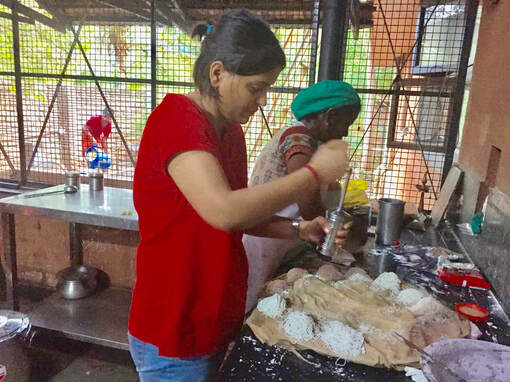
Panchakarma comes from the Sanskrit words pancha meaning five and karma meaning action. Panchakarma entails age-old healing therapies for rejuvenation and eliminating excesses and toxins from the body-mind-spirit. The five actions are: snehana (oleation), vamana (emesis or vomiting), virechana (purgation), basti (enema), and rakta moksha (bloodletting). Rakta moksha is rarely performed in India now and is illegal in the United States. Waste products in the blood can produce many skin ailments and other conditions; people sometimes donate blood to achieve the benefits of this therapy.
Preparation before these therapies begin is important. The tissues of the body must be nourished and prepared and all the channels must be opened. Snehana is often applied internally as well as externally in abyhanga (four-handed oil massage) or shirodara, the pouring of warm herbal oil in a continuous stream on the forehead. Shirodara soothes and invigorates the senses and the mind. Nasya (medicated oil applied in the nostrils) is another form of snehana as is the consumption of ghee (clarified cultured butter). Basti (enema) may also contain sneha as it can contain medicated oil or ghee. The Sanskrit word sneha implies love and tenderness. Shehana therapies anoint, lubricate and caress the internal and external body. The outpouring of caring energy from practitioner into the receiver helps the body-mind-spirit remember its true nature.
Preparation before these therapies begin is important. The tissues of the body must be nourished and prepared and all the channels must be opened. Snehana is often applied internally as well as externally in abyhanga (four-handed oil massage) or shirodara, the pouring of warm herbal oil in a continuous stream on the forehead. Shirodara soothes and invigorates the senses and the mind. Nasya (medicated oil applied in the nostrils) is another form of snehana as is the consumption of ghee (clarified cultured butter). Basti (enema) may also contain sneha as it can contain medicated oil or ghee. The Sanskrit word sneha implies love and tenderness. Shehana therapies anoint, lubricate and caress the internal and external body. The outpouring of caring energy from practitioner into the receiver helps the body-mind-spirit remember its true nature.
Svedana
Svedana therapy induces sweating by way of the skin, hair follicles and through fat tissue. As the fire element increases, agni (digestion) is stimulated as ama (toxic residue) is expulsed. Sweat is one of the waste materials produced by the body's fat tissue. There are thirteen classic forms of sweat therapy and each form has many variations. Svedana can be wet or dry and these can be soft or mild, especially for delicate conditions. In the photo above, therapists prepare for a wet svedana with continuous pouring of warm herbal decoction using silver teapots.
Since all energy is to be directed toward purification and elimination, shaving and cutting hair are not permitted, nor is cutting the nails, as these actions stimulate growth. Growth of new tissue comes later, in the rasayana (rejuvenative) phase. Pratyahara (withdrawal of the senses) is practiced and rest is the main activity. Panchakarma is not the time to catch up on work, your reading or social media. In some panchakarma clinics cell phones, tablets and computers are locked away; in others self-monitoring is allowed, but the use of such devices should be limited.
Since all energy is to be directed toward purification and elimination, shaving and cutting hair are not permitted, nor is cutting the nails, as these actions stimulate growth. Growth of new tissue comes later, in the rasayana (rejuvenative) phase. Pratyahara (withdrawal of the senses) is practiced and rest is the main activity. Panchakarma is not the time to catch up on work, your reading or social media. In some panchakarma clinics cell phones, tablets and computers are locked away; in others self-monitoring is allowed, but the use of such devices should be limited.
Food During Panchakarma
Diet during panchakarma is appropriate to the dosha and to the season: generally whole cooked grains and vegetables with some pulses and fruits. Panchakarma is not a fast, although often people lose weight. The Vedas say our true nature is boundless and immortal. Yoga, pranayama, meditation, chanting and spiritual practices can greatly aid our progress in realizing this state.
In the photo above cooks are preparing idli, a savory steamed cake made from fermented lentils and rice for a panchakarma meal.
In the photo above cooks are preparing idli, a savory steamed cake made from fermented lentils and rice for a panchakarma meal.
Panchakarma in the United States and in India
Daily consultations with an ayurvedic doctor monitor progress and determine the course of treatment. Cost is one of the differences between panchakarma in the United States and in India. Panchakarma in India generally costs a fourth of what one would pay in the United States. A week-long panchakarma in the United States will often combine many treatments almost every day. Multi-tasking Americans often want to do things in a hurry, but panchakarma is powerful, slow and gentle. A much wider range of treatments are practiced in India also.
I am taking a group for a 21-day panchakarma at Vaidyagrama Healing Village near Coimbatore, India this July and expect to lead similar trips in the future.
The aim overall of panchakarma can be summed up by Patanjali's third Yoga Sutra : "then the seer dwells in his own true splendor."
I am taking a group for a 21-day panchakarma at Vaidyagrama Healing Village near Coimbatore, India this July and expect to lead similar trips in the future.
The aim overall of panchakarma can be summed up by Patanjali's third Yoga Sutra : "then the seer dwells in his own true splendor."
Questions?
Contact me at [email protected]
Contact me at [email protected]




